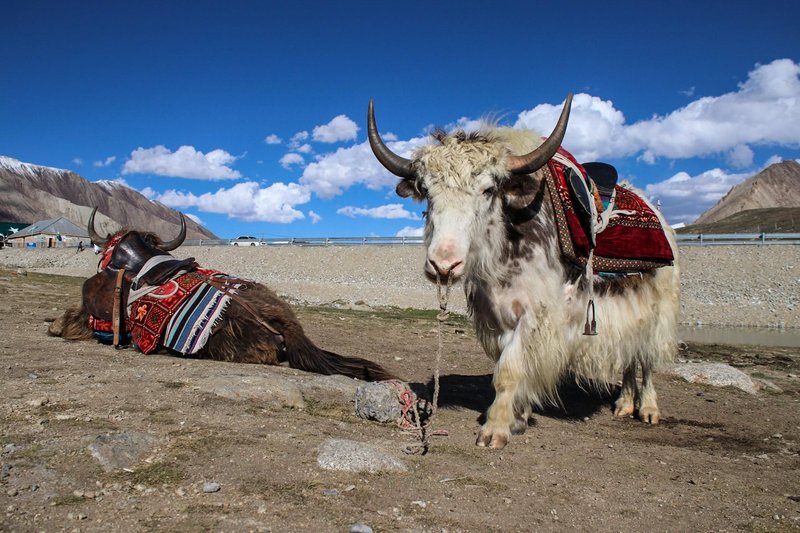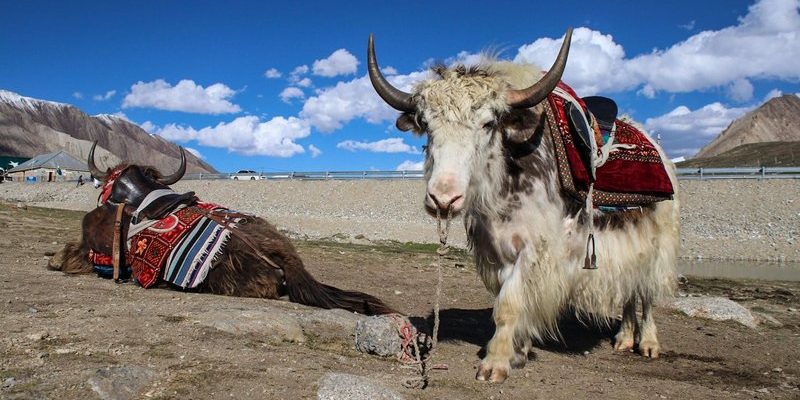
Think of yaks as the “mountain tanks” of the animal kingdom. They’ve evolved over thousands of years, developing features that not only help them survive but thrive in extreme conditions. Just like a well-designed vehicle that can handle rough terrains, yaks have their own set of tools—both physical and behavioral. So, let’s dig into how these incredible animals manage to live in such harsh environments and what makes them so uniquely adapted to their surroundings.
The Yak’s Mighty Adaptations
Yaks have some impressive physical characteristics that enable them to survive in the cold, thin air of high altitudes. First off, their **thick fur coat** is a game-changer. This fur is not just for looks; it’s a dual-layer system that traps heat. The outer layer repels moisture, while the undercoat is soft and insulating. When temperatures drop to as low as -40°F (-40°C), you can see how this thick fur acts like a warm blanket.
Additionally, yaks have a unique **body structure**. Their large lungs and heart are designed for optimal oxygen intake, helping them thrive in low-oxygen environments. It’s like they have their own built-in oxygen tanks! When you compare them to other livestock, yaks can function well at elevations over 10,000 feet (3,048 meters). They can even handle incredibly steep terrains, making them excellent climbers on rocky mountainsides.
Another fascinating adaptation is their **hooves**. Yak hooves are wide and have a leathery sole, which helps them grip slippery surfaces and navigate rocky paths. This feature is essential for stability in the rough terrains they inhabit. Their physical traits aren’t just impressive; they are crucial for survival, demonstrating nature’s ability to sculpt animals perfectly suited for their environments.
Diet: Grazing on the Edge
Yaks are herbivores, grazing primarily on grasses, shrubs, and lichens. But finding food in the harsh climates they inhabit isn’t always easy. During winter months, the landscape transforms into a frozen wonderland, covering potential meals with snow. So, how do yaks cope?
You might be surprised to learn that yaks are true foragers. They can dig through snow to find grass or other vegetation underneath. Their immense strength allows them to break the frozen earth, which is a skill few animals can match. It’s like they have a built-in snow shovel, thanks to their strong legs and hooves.
In addition to digging, yaks have a unique ability to **digest tough plant material**. Their stomachs have several chambers, allowing them to break down fibrous plants effectively. This means they can extract more nutrients from food sources that would be insufficient for other animals, ensuring they get the energy they need to survive in challenging conditions.
Social Behavior and Herding Instincts
Social structures play a crucial role in yak survival. Yaks are generally found in herds, which helps protect them from predators like wolves and leopards. Herding offers many advantages, including shared knowledge about grazing areas and collective decision-making when migrating for better resources.
Yaks have a strong **bond with their young**. Mothers are incredibly protective, often staying close to their calves to ensure their safety. This social behavior isn’t just for warmth or companionship; it’s a survival strategy. By sticking together, yaks can defend against threats and work as a unit to find food and shelter.
Interestingly, the social dynamics within yak herds are quite complex. Dominant males often lead, guiding the group to new grazing locations. You might be wondering how this affects their survival. Simply put, having a leader can make navigating harsh environments much more efficient. When you have a strong leader, the herd can move confidently and avoid danger more effectively.
Adaptation to Extreme Weather
Weather in high-altitude regions can be unpredictable, often swinging from scorching sun during the day to freezing temperatures at night. How do yaks handle such extremes?
Their thick fur, as mentioned earlier, protects them from biting winds and cold temperatures. Yet, there’s more to it. Yaks also possess a unique behavior called **”sheltering.”** When the weather turns hostile, yaks instinctively seek shelter in rocky outcrops or behind natural windbreaks. This behavior helps them conserve warmth and prevent exposure to severe conditions.
During the summer, the same coat that kept them warm in winter can become a burden in the heat. To cope, yaks naturally shed their thick winter coat, revealing a lighter layer underneath. This shedding is like having a built-in air conditioning system, allowing them to adapt to rising temperatures. It’s fascinating how they can transition so seamlessly between seasons to ensure their survival.
The Role of Yaks in Human Cultures
Yaks aren’t just remarkable for their survival tactics; they also hold significant cultural importance in the regions where they live. For centuries, yaks have been essential to the livelihoods of people in the Himalayas and Tibetan Plateau. They provide everything from **milk** and **meat** to **wool** and **transportation**.
Many communities rely on yak milk for nutrition, as it’s rich in fat and protein. It’s often turned into yogurt and cheese, staples in the diets of local populations. The meat is used for food, while the fur and hide are crafted into warm clothing and blankets. Think of yaks as “living supermarkets” that offer a variety of resources to sustain local cultures and economies.
Moreover, yaks are often used as pack animals. They can carry heavy loads across treacherous terrains, making them invaluable for trade and transportation in remote areas. Their adaptability and strength enable them to help humans navigate the same harsh environments that challenge their survival, showcasing a beautiful bond between animal and human.
Conservation and Challenges Ahead
Despite their incredible adaptations, yaks face challenges in the modern world. Climate change poses a significant threat, altering the delicate ecosystems they depend on. Rising temperatures and changing precipitation patterns can lead to food shortages, putting immense pressure on yak populations.
Moreover, habitat loss is becoming increasingly common as human development spreads into traditional grazing areas. This encroachment reduces the available land for yaks and diminishes their resources. It’s a complex issue that requires cooperation between local communities and conservationists to ensure the future of these remarkable animals.
Fortunately, there are ongoing efforts to **protect yak populations**. Conservation initiatives aim to preserve their natural habitats while promoting sustainable farming practices. Educating local communities about the importance of yaks and their ecosystems is crucial in this fight. After all, protecting yaks means protecting the cultures and livelihoods that depend on them.
Yaks are truly fascinating creatures, uniquely equipped to survive and thrive in some of the toughest environments on Earth. Their thick fur, incredible foraging abilities, and social behaviors make them masters of adaptation. Plus, their integral role in supporting local cultures showcases the deep connection between these animals and the people who rely on them.
As we face climate challenges and habitat loss, understanding and protecting yaks is more important than ever. They are more than just animals; they are a vital part of a larger ecosystem and human heritage. So next time you think about life in harsh environments, remember the yak—a true survivor!

